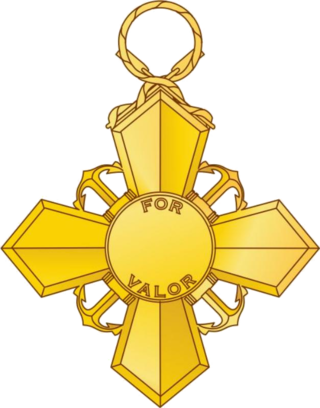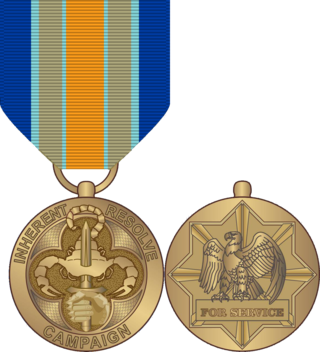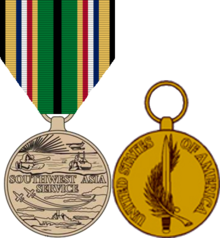The National Defense Service Medal (NDSM) is a service award of the United States Armed Forces established by President Dwight D. Eisenhower in 1953. It is awarded to every member of the U.S. Armed Forces who has served during any one of four specified periods of armed conflict or national emergency from June 27, 1950 through December 31, 2022. Combat or "in theater" service is not a requirement for the award.
The World War II Victory Medal is a service medal of the United States military which was established by an Act of Congress on 6 July 1945 and promulgated by Section V, War Department Bulletin 12, 1945.

The Humanitarian Service Medal (HSM) is a military service medal of the United States Armed Forces which was created on January 19, 1977 by President Gerald Ford under Executive Order 11965. The medal may be awarded to members of the United States military who distinguish themselves by meritorious participation in specified military acts or operations of a humanitarian nature.
The Vietnam Service Medal is a military award of the United States Armed Forces established on 8 July 1965 by order of President Lyndon B. Johnson. The medal is awarded to recognize service during the Vietnam War by all members of the U.S. Armed Forces provided they meet the award requirements.
The Korean Service Medal (KSM) is a military award for service in the United States Armed Forces and was established November 8, 1950, by executive order of President Harry Truman. The Korean Service Medal is the primary US military award for service or participation in operations in the Korean area between June 27, 1950, and July 27, 1954.

A service star is a miniature bronze or silver five-pointed star 3⁄16 inch (4.8 mm) in diameter that is authorized to be worn by members of the eight uniformed services of the United States on medals and ribbons to denote an additional award or service period. The service star may also be referred to as a campaign star or battle star depending on which award the star is authorized for and the manner in which the device is used for the award.
The Armed Forces Expeditionary Medal (AFEM) is a military award of the United States Armed Forces, which was first created in 1961 by Executive Order of President John Kennedy. The medal is awarded to members of the U.S. Armed Forces who, after July 1, 1958, participated in U.S. military operations, U.S. operations in direct support of the United Nations, or U.S. operations of assistance for friendly foreign nations.
The Meritorious Team Commendation (MTC) is a unit award of the United States Coast Guard. Created on 22 December 1993, the Meritorious Team Commendation is awarded for performance of exceptional actions that would normally warrant a Commandant's Letter of Commendation if recognizing an individual. Recognized groups must also display cohesion and teamwork noticeable to upper echelon commanders. The MTC is awarded to groups or teams that are not identifiable by OPFAC as a United States Coast Guard unit. The MTC may be awarded to military personnel, Coast Guard Auxiliarists, and civilians.

The Afghanistan Campaign Medal (ACM) is a military award of the United States Armed Forces which was created by Executive Order 13363 of President George W. Bush on November 29, 2004, and became available for general distribution in June 2005. The medal was designed by the U.S. Army Institute of Heraldry.

The Iraq Campaign Medal (ICM) is a military award of the United States Armed Forces which was created by Executive Order 13363 of U.S. President George W. Bush on 29 November 2004, and became available for general distribution in June 2005. The medal was designed by the U.S. Army Institute of Heraldry and was awarded during the Iraq War, from 19 March 2003 to 31 December 2011.
The Marine Corps Security Guard Ribbon is a United States Marine Corps military award that was established by order of Secretary of the Navy John Howard Dalton on 15 July 1997. The award recognizes those Marine Corps personnel who have served as U.S. Embassy Security Guards and is retroactive to 28 January 1949.

The Global War on Terrorism Service Medal (GWOT-SM) is a military award of the United States Armed Forces which was created through Executive Order 13289 on 12 March 2003, by President George W. Bush. The medal recognizes those military service members who have supported operations to counter terrorism in the War on Terror from 11 September 2001, to a date yet to be determined.
The Global War on Terrorism Expeditionary Medal (GWOT-EM) is a United States Armed Forces award created by George W. Bush on 12 March 2003, through Executive Order 13289. The medal recognizes those military service members who have deployed overseas in direct service to the War on Terror from 11 September 2001 to a date to be determined. Prior to 30 April 2005, the medal was awarded for service within Iraq and Afghanistan, but has been replaced with the Iraq Campaign Medal and Afghanistan Campaign Medal and now serves primarily as recognition for personnel who have deployed in support of the War on Terror to locations beyond Iraq and Afghanistan. In a similar fashion the Inherent Resolve Campaign Medal is now issued instead for service in the fight against ISIS, with eligibility retroactive to 15 June 2014.
The Kosovo Campaign Medal (KCM) is a military award of the United States Armed Forces established by Executive Order 13154 of President Bill Clinton on May 3, 2000. The medal recognizes military service performed in Kosovo from March 24, 1999 through December 31, 2013.
The Armed Forces Service Medal (AFSM) is a military award of the United States military that was created on January 11, 1996, by President Bill Clinton under Executive Order 12985. The AFSM is a deployed service medal that is presented to those service members who engage in "significant activity" for which no other U.S. campaign or service medal is authorized.

A medal ribbon, service ribbon or ribbon bar is a small ribbon, mounted on a small metal bar equipped with an attaching device, which is generally issued for wear in place of a medal when it is not appropriate to wear the actual medal. Each country's government has its own rules on what ribbons can be worn in what circumstances and in which order. This is usually defined in an official document and is called "the order of precedence" or "the order of wearing." In some countries, some awards are "ribbon only," having no associated medal.

The Kuwait Liberation Medal is a medal created in 1994 that was issued by the government of Kuwait to both local and foreign military personnel who served in the Persian Gulf War's "Liberation of Kuwait" campaign phase of 1990 and 31 August 1993.

The Naut Tahrir al-Kuwait was instituted by King Fahd ibn Abdulaziz of Saudi Arabia for service during the Liberation of Kuwait campaign.

The Coast Guard Cross (CGC) is the United States Coast Guard's second highest military decoration for Coast Guardsmen who distinguish themselves extraordinary heroism in combat with an armed enemy force. Established by Act of Congress on 15 October 2010, it is intended to recognize members of the United States Coast Guard for extraordinary heroism in action. Coast Guardsmen serving under the Department of the Navy would be eligible for the Navy Cross. This medal, though approved, has not yet been awarded. By virtue of having never been awarded, it is the rarest United States military award.

The Inherent Resolve Campaign Medal is a United States Department of Defense service award and campaign medal. The medal was established by Executive Order on 30 March 2016 by U.S. President Barack Obama. The medal may be awarded to members of the U.S. Army, Navy, Marine Corps, Air Force, and Coast Guard, for service in Iraq, Syria, or contiguous waters or airspace retroactively from 15 June 2014 to a date yet to be determined. Service members who were awarded the Global War on Terrorism Expeditionary Medal for service that is now covered by the Inherent Resolve Campaign Medal may make application to be awarded the Inherent Resolve Campaign Medal in lieu of the Global War on Terrorism Expeditionary Medal. No service member will be entitled to the Global War on Terrorism Expeditionary Medal and Inherent Resolve Campaign Medal for the same action, time period, or service.










